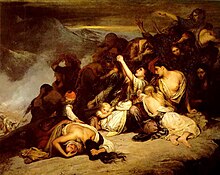Souliote War (1803)
| Souliote War | |||||||
|---|---|---|---|---|---|---|---|
 Les Femmes souliotes by Ary Scheffer (1795–1858). |
|||||||
|
|||||||
| Belligerents | |||||||
| Souliotes | Pashalik of Yanina | ||||||
| Commanders and leaders | |||||||
|
Ali Pasha Veli Pasha |
|||||||
| Strength | |||||||
| 2,000 | |||||||
The war between the warlike communities of Souliotes in Epirus and the local Ottoman ruler, Ali Pasha, at 1803, was the last of a series of conflicts, known as the Souliote Wars, that led, finally, to the capitulation and expulsion of the Souliotes.
During the 500-year reign of the Ottoman Empire, the fierce Souliotes enjoyed an autonomous status, known as the Souliote Confederacy. The Confederacy was established during the 16th century, in the mountains of Thesprotia, near the towns of Paramythia and Parga. The Souliotes established an autonomous confederacy dominating the villages in the remote mountainous areas of Epirus, where they successfully resisted Ottoman rule. At the height of its power, in the second half of the 18th century, the Souliot state is estimated to have comprised up to 12,000 inhabitants scattered across approximately 60 villages.
In 1803, the Sultan asked Ali Pasha to press immediately a planned siege of the Souliotes, after being transmitted information that the Souliotes had procured considerable supplies of munitions from French ships. The Souliotes obtained all of their supplies from Parga, and also acquired support from Europe. Russia and France provided weapons and ammunition to them. For the European powers, the Souliotes were seen as an instrument to weaken the Ottoman Empire. When the British politicians turned to the Ottoman Empire in order to strengthen their forces against Napoleon, the weapons and ammunition supplies were interrupted. Without support from outside and wearied by years of siege, the unity of the Souliot clans began to fray.
The Botsaris family left Souli for political reasons and parleyed with Ali Pasha. The Souliotes remaining in Souli gathered in Saint George's Orthodox Church and agreed to fight to the death. Among them were no more than 2000 armed men. The main leaders were Fotos Tzavellas, Dimos Drakos, Tousias Zervas, Koutzonikas, Gogkas Daglis, Yiannakis Sehos, Fotomaras, Tzavaras, Veikos, Panou, Zigouris Diamadis, and Giorgos Bousbos. Amazingly, these Souliotes won all the ensuing decisive battles and forced Ali Pasha to build castles in neighboring villages so as to prepare himself for a long siege.
...
Wikipedia
